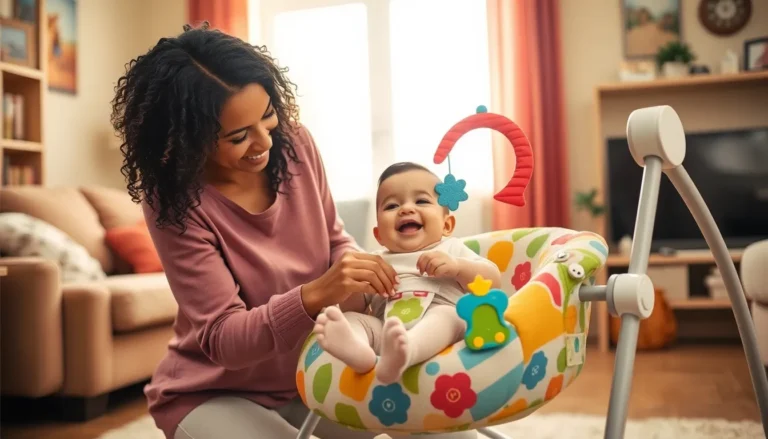Choosing to put a child up for adoption can feel like navigating a rollercoaster with a blindfold on. It’s a mix of emotions, decisions, and maybe even a few unexpected twists. But let’s face it—sometimes life throws curveballs, and the best option isn’t always the easiest one.
Table of Contents
ToggleUnderstanding Adoption
Adoption serves as a legal process that transfers parental rights from biological parents to adoptive ones. It provides a child with the opportunity for stability and support within a nurturing environment. In the United States, around 135,000 children are adopted each year, demonstrating the significant number of families choosing this path.
There are various types of adoption available. Domestic adoption occurs within the same country, while international adoption involves bringing a child from another nation. Open adoption allows for communication and contact between biological and adoptive families, fostering relationships that can benefit the child.
The reasons for choosing adoption can vary widely. Some biological parents face financial hardships and cannot provide suitable care for their child. Others may not be ready for the responsibilities of parenthood. Regardless of the circumstances, each decision surrounding adoption demands careful reflection and support.
In terms of the adoption process, it typically includes several key steps. Birth parents often consider counseling to understand their feelings and options. Legal procedures involve termination of parental rights, home studies for adoptive families, and finalization in court.
Support systems play a crucial role in the adoption experience. Organizations that specialize in adoption provide resources and workshops to educate prospective parents. These services facilitate connections within the adoption community, helping families navigate challenges effectively.
Adoption affects many lives, creating new family dynamics and relationships. Understanding these elements ensures informed choices, ultimately leading to positive outcomes for children and families.
Reasons to Put a Child Up for Adoption
Choices exist for parents considering adoption. Various factors influence the decision, whether practical or emotional.
Financial Considerations
Financial strain often creates challenges for parents. Raising a child involves significant expenses, including healthcare, education, and daily living costs. Many parents feel unprepared to manage these financial responsibilities. Struggling to meet basic needs can lead to difficult choices about a child’s future. In some cases, parents choose adoption to ensure their child has access to resources they cannot provide. Adoption allows children to grow up in stable environments that offer better financial security.
Emotional Factors
Emotional turmoil frequently accompanies the decision to place a child for adoption. Feelings of love, guilt, and fear can overwhelm parents. Some parents may recognize their inability to provide the nurturing environment a child deserves. They may grapple with the knowledge that their decision signifies a profound sacrifice. Personal circumstances, such as relationship issues or mental health challenges, can also influence this emotional journey. Seeking support from counseling services or adoption agencies helps parents navigate these complex feelings and make informed decisions.
The Adoption Process
The adoption process involves critical steps ensuring the best environment for the child and parents. Each choice significantly influences the future of everyone involved.
Choosing an Adoption Agency
Selecting an adoption agency is crucial for the success of the process. Researching options helps identify reputable agencies specialized in adoption. Local agencies often offer personalized support through each stage. Finding a licensed agency ensures adherence to state laws and regulations. Asking for recommendations from trusted organizations or friends can also provide valuable insight. Exploring both open and closed adoption options allows potential parents to understand the implications of ongoing contact with biological families.
Legal Requirements
Legal requirements represent an essential part of the adoption process. Each state has specific laws governing adoption that prospective parents must follow. Completing a thorough background check shows eligibility to adopt. Attending pre-adoption training can also help prepare parents for their new roles. Gathering necessary documents, such as medical and financial information, streamlines the process. Finalizing the adoption in court involves a legal procedure confirming the transfer of parental rights. Understanding these requirements ensures a smoother transition into parenthood.
Types of Adoption
Adoption encompasses various types, each presenting unique dynamics and considerations. Understanding these differences aids prospective parents and birth parents in making informed decisions.
Open Adoption
Open adoption promotes ongoing communication between biological and adoptive families. This arrangement allows for shared updates, visits, and even exchanges of letters. Many birth parents appreciate the connection, as it provides assurance regarding their child’s well-being. It facilitates a transparent relationship and fosters a sense of shared parenting. Adoptive parents often gain valuable insights into the child’s heritage, contributing to the child’s identity formation. In the U.S., approximately 60% of adoptions today are open, highlighting its growing popularity and acceptance in society.
Closed Adoption
Closed adoption involves no contact or exchange of information between biological and adoptive families. In this scenario, the birth parents relinquish their parental rights without ongoing communication. Many seek closed adoption for privacy reasons, wanting to protect their identities and personal histories. This type can alleviate confusion for the child regarding their lineage, offering a clear separation between families. However, some children raised in closed adoptions may later seek information about their biological roots. Statistics indicate that around 40% of adoptions in the U.S. continue to be closed, revealing a significant choice for many families.
Support Systems for Birth Parents
Support systems for birth parents play a crucial role during the adoption process. Counseling services offer emotional guidance, helping parents cope with feelings of love, guilt, and fear. Adoption agencies also provide essential resources, including educational materials and workshops that assist in navigating the complexities of adoption.
Peer support groups connect birth parents with others who share similar experiences. These gatherings foster an environment of understanding, allowing for open discussions about challenges and emotions. Many find comfort in sharing their stories and learning from one another.
Legal assistance proves beneficial as well. Parents may need help understanding their rights and the adoption process. Professionals can clarify legal terminologies and requirements, ensuring parents feel informed and confident in their choices.
Community resources expand the available support. Local organizations often offer financial assistance, healthcare options, and parenting classes. Accessing these services can alleviate some burdens, creating a more stable environment for both the birth parent and the child.
Mental health professionals specialize in adoption-related issues. Therapists can guide parents through their emotions, fostering resilience and self-care. Establishing a strong mental health foundation enhances decision-making abilities regarding adoption.
Online forums and hotline services further extend support. Virtual platforms allow birth parents to seek advice and share experiences at their convenience. Many appreciate having access to resources whenever needed.
Overall, these support systems empower birth parents throughout their adoption journey. By exploring various options, parents can create a network that best suits their needs and ensures positive outcomes for themselves and their children.
Choosing to put a child up for adoption is a deeply personal decision that requires immense courage and reflection. It’s a path that not only impacts the lives of birth parents but also shapes the future of the child. With the right support and resources, parents can navigate this emotional journey while ensuring their child finds a loving and stable home. Understanding the various types of adoption and the legal processes involved is crucial in making informed choices. Ultimately, the decision to adopt can lead to positive outcomes, fostering connections that benefit everyone involved.



